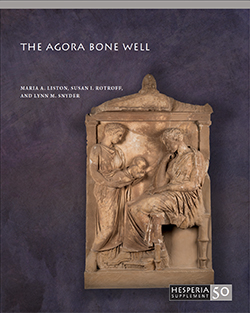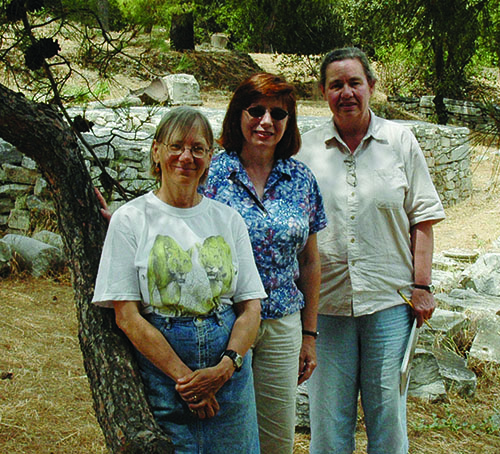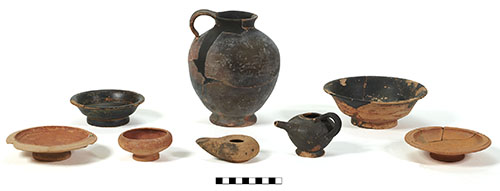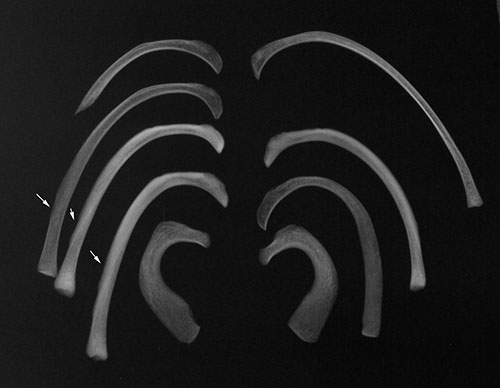
The Mystery of the Bones in the Well: Reflections from the Authors
 A new ASCSA publication, coauthored by Maria A. Liston, Susan I. Rotroff, and Lynn M. Snyder, presents the material of the Agora Bone Well in full for the first time. The authors spoke with the American School about their new book, The Agora Bone Well (Hesperia Supplement 50), and some of the challenges and rewards of studying such a difficult deposit.
A new ASCSA publication, coauthored by Maria A. Liston, Susan I. Rotroff, and Lynn M. Snyder, presents the material of the Agora Bone Well in full for the first time. The authors spoke with the American School about their new book, The Agora Bone Well (Hesperia Supplement 50), and some of the challenges and rewards of studying such a difficult deposit.
In June 1938, Dorothy Burr Thompson excavated a well on the edge of the Athenian Agora and was expecting to find an ordinary ancient water source. Instead, she unearthed the bones of over 450 infants, the remains of a few older individuals, and a variety of animal bones, including those of over 150 dogs. Such a collection of skeletal material had never been seen before, and the deposit was soon known as “the Agora Bone Well.” There was also an assortment of artifacts in the well, including pottery, an ivory chape, a marble herm, and bits of bronze. J. Lawrence Angel examined the bones the same month they were excavated. In 1945, he published an article in Hesperia, in which he included a brief summary of the human remains from the Agora Bone Well in a more comprehensive catalogue of skeletal remains from Attica. But after that, the material was stored in boxes, bags, and drawers, and it would have to wait several decades before being fully studied and published.

Susan Rotroff, Maria Liston, and Lynn Snyder at the site of the Agora Bone Well
Even though Thompson did not publish the material found in the Agora Bone Well herself, the curious circumstances of the deposit never left her mind. In the 1970s, Thompson mentioned the well to Susan Rotroff, her student and research assistant. Rotroff remembers, “[Thompson] brought it to my attention and urged me to try to solve the mystery, so it was always on my radar. I was familiar with the ceramic contents because of my work on the Hellenistic pottery, so I was thrilled when others with the necessary expertise became interested as well!” Lynn Snyder stumbled across the well as a graduate student studying anthropology at the University of Tennessee. The Classics Department sent out a query across campus to see if anyone was interested in studying animal bones for a few weeks in the Aegean. “This led me, a North American zooarchaeologist without any experience in the classics, to spend many summers in East Crete on the Kavousi project,” recalls Synder. She stopped in Athens at the American School on many of these visits, where she met Rotroff and learned about the Agora Bone Well. She became interested in studying the dog remains, and joined the team. Some years later, Susan and Lynn invited Maria Liston to join them. Liston and Snyder were fellow students at the University of Tennessee and had worked together at Kavousi. Liston knew of the well because she had already considered studying the remains for her dissertation while the permits for the Kavousi bones were in limbo. This time around, Liston jumped on board and began a complete restudy of the human remains.

Photograph from the Agora Excavations archive showing the Agora Bone Well in the lower right
In the end, the right team of people came together at the right time. The authors agree that the delay between excavation and publication gave science and technology a chance to develop. “The knowledge of medicine and science needed to study the infant and dog bones did not exist in the 1930s. The necessary science to study the pathology of the infant bones didn’t even exist in the 1990s when I first considered studying the deposit. While pottery studies were certainly more advanced in the 1930s than those of bone, the delay allowed a more nuanced and context-based study of the pottery,” Liston explains. Snyder agrees, highlighting the foresight of Thompson and her team: “It is to the credit of the excavators of the Agora Bone Well that all bone remains were saved for preliminary and future analyses.” Liston sums up the situation perfectly, describing the deposit as one “whose time has finally arrived. It could not have been studied in this way even 10–15 years earlier.”

Fine-ware vessels found intact or nearly intact in the Agora Bone Well
But Rotroff acknowledges that there was probably more than just insufficient technology that led to the delay. “I think there was also a natural unwillingness to examine this disturbing material—there had to be some sad story behind so many dead infants,” Rotroff says. Archaeologists working with bones rely on training as well as the archaeological context to help them create emotional barriers so they can handle forensic cases. But at times, the Agora Bone Well remains were overwhelming. Liston candidly admits that “thinking of the amount of grief that must be represented by the deaths of all these infants sometimes was just too much, and I had to walk away. I don’t believe the arguments that say ancient people didn’t grieve for their infants because they died so often. . . . I expect that nearly all of the parents of these infants inevitably grieved for their loss, and the thought of that was very difficult at times.” Snyder had a similar experience, explaining that the “sheer number of infants and dogs gathered in one place, in such a short period of time, forces one to consider the actual circumstances under which they died. Each event represented in the well must have been fraught with emotion and sadness.”

Radiograph of the ribs of an infant found in the Agora Bone Well with sites of fractures indicated by arrows
Until this publication, there have been several theories to explain the circumstances of the well, mostly leaning toward catastrophic or sensational events, including epidemics, Sulla’s sack of Athens in 86 B.C., or even human sacrifices and mass infanticide. Rotroff explains, “Our interpretation differs in being perhaps more prosaic—nothing spectacular, just day-to-day infant mortality. In a way, though, it is even more shocking to consider the very high rate of infant mortality in the ancient world in comparison with what we experience ourselves.” Liston agrees: “Our conclusions are more mundane, but provide a much better window into understanding a little-known aspect of private life in ancient Athens.” As for the animal bones, Snyder believes the dogs were purposely put into the well with the infants, although the exact reason has yet to be determined. The dog remains do not have any evidence that would suggest they entered the well as part of some sort of purge of unwanted dog populations or the result of a cleanup following natural deaths. Instead, Snyder thinks that the “well deposit is likely to be another expression of the ancient and close relationship between humans and their oldest ‘domestic’ animal companions.” The main difference between the explanations found in The Agora Bone Well and previous attempts to explain the deposit is that the authors base their conclusions on the scientific examination of the bones. The authors offer a rich collection of comparative material and present a starting point for future discussions, while also putting a human face on tragic events that happened thousands of years ago.

Four skulls of adult dogs found in the Agora Bone Well
Now that The Agora Bone Well has been published, the authors will be going their separate ways. Rotroff is collaborating with Kathleen Lynch from the University of Cincinnati to study the 5th-century B.C. pottery of the Crossroad Enclosure (“no human bones!”), while Liston is studying Early Christian/Byzantine graves from a cemetery associated with a hospital for patients with serious diseases at the Sanctuary of Ismenion Apollo in Thebes. Liston is also looking at another well that was used to dispose of the remains of both adults and infants in the Roman Gymnasium at Eretria. Snyder, who is semiretired, is the Exhibits and Museum Coordinator for the History Museum of the Historical Society of Quincy and Adams County, in Quincy, Illinois. She is still trying to work an exhibit on the relationship of dogs and people into the schedule.
The authors agree that one of the most rewarding aspects of this project was working with other scholars toward a common goal and crossing interdisciplinary boundaries to answer some very basic questions about ordinary life in ancient Athens. For Rotroff, though, it was a little more personal: “I was happy to finish something that my mentor Dorothy Thompson had begun.”